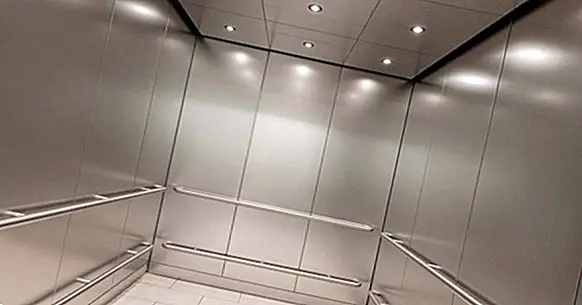Phobia to the elevators: symptoms, causes and how to face it
The fear of being locked inside a small space can appear at any time in our lives. However, when this fear is exaggerated and prevents us from developing our normal day to day life we may find ourselves facing a phobia. This is what happens with elevator phobia .
Throughout this article we will describe what this type of specific phobia consists of, as well as what its symptoms and causes are and what the person who suffers it can do to manage the discomfort it causes.
- Related article: "Types of phobias: exploring the disorders of fear"
What is elevator phobia?
The phobia of elevators manifests itself as an exacerbated, irrational and uncontrollable fear of this type of machinery. However, although their symptoms are the same as for any other specific anxiety disorder, the fear of elevators is not considered a phobia per se, but is categorized within two other very common phobias: claustrophobia and the acrophobia.
Claustrophobia consists of an irrational fear of enclosed spaces or enclosures or of limited dimensions , whereas acrophobia is the excessive fear of heights.
Understanding these two concepts, it is much easier to understand what is the fear of elevators. In those cases in which the person begins to experience symptoms of anxiety at the moment in which it rises to an elevator, or even when knowing that it is going to raise, it is a fear own of the claustrophobia; due to the small space in which the person is.
However, when this irrational fear appears at the thought that a certain height is being reached, the basis of the fear of the elevators is in the acrophobia . This fear tends to increase in those elevators that have glass walls, since the person experiences a greater sensation of being suspended in the air.
- Maybe you're interested: "The 7 types of anxiety (causes and symptoms)"
What symptoms are experienced?
Whatever the basis or origin of the elevator phobia, people who suffer from it tend to experience excessive, irrational and uncontrollable fear of elevators , elevators or forklifts, perceiving an intense anxiety response every time they are exposed to the possibility of having to ride one of them.
The main consequence of this phobia is that the person tends to carry out all kinds of behaviors, acts and behaviors aimed at avoiding the dreaded situation or escaping from it as soon as possible.
Because these devices are found in virtually all places, the phobia of elevators can be very annoying and, sometimes, highly disabling, interfering in an important way in the day to day of the person. However, as we will see, There are a series of guidelines that can be followed to better tolerate these situations full of anxiety or, in the case that it supposes a great problem, very effective psychological treatments.
Since it is an irrational fear of a specific object or situation, elevator phobia shares symptoms with the rest of specific phobias , being the most characteristic manifestation of high levels of anxiety in people who suffer from this phobia.
Although the amount of symptoms and the intensity of these can vary from person to person, so that this fear can be classified as phobic, the person must present some of the symptoms typical of the three categories associated with phobias: physical symptoms, cognitive symptoms and behavioral symptoms.
1. Physical symptoms
Because it is an anxious symptomatology, before the appearance of the phobic stimulus, the person usually experiences a series of alterations and changes in their organism. The origin of these changes comes from an overactivity of the autonomic nervous system , and can generate the following effects:
- Increase in the cardiac rate.
- Acceleration of breathing .
- Feeling of suffocation and shortness of breath.
- Muscle tension.
- Increased levels of sweating .
- Headaches
- Gastric problems
- Vertigos
- Nausea or vomiting .
- Fainting and loss of consciousness.
2. Cognitive symptoms
These physical symptoms are accompanied by a series of intrusive and irrational ideas about the supposed danger of elevators. These distorted beliefs play a double role, since they originate the physical symptoms and also the powers when they appear since the person can not remove these ideas from the head .
These cognitive symptoms include:
- Intrusive and uncontrollable beliefs and ideas about the phobic stimulus.
- Obsessive speculations.
- Catastrophic images about possible scenarios or situations.
- Fear of losing control .
- Feeling of unreality
3.Behavioral symptoms
The third group of symptoms is one in which all the behaviors or behavior patterns that appear in response to the phobic stimulus are included. These behaviors aim to avoid the dreaded situation (avoiding behaviors) or escape once the person has already encountered the phobic stimulus (escape behaviors).
In the avoidance behaviors, the person performs all possible behaviors or acts that allow him to avoid the possibility of having to face the stimulus. In this case it could be up the stairs instead of taking the elevator, regardless of the number of floors.
As for the escape behaviors, these appear when the person is already inside the device, within which he will do everything necessary to leave as soon as possible. For example, pressing compulsively the door opening button .
What is the cause?
Trying to determine the specific origin of phobias can be a very important task complicated, since on many occasions There is not a single factor that triggers the disorder. But the person feels a fear of the elevators but is not aware of the reason.
However, there are theories that point to the idea that a genetic predisposition of the person, together with the presence of an event or traumatic situation related in some way to the elevators will trigger, quite possibly, the appearance of said phobia.
How to face this fear?
There are a number of keys or guidelines that can help people who suffer a great fear of elevators to avoid the increase in feelings of anxiety. Some of these guidelines are the following:
- Breathe slowly , making deep inspirations and exhaling slowly to reduce the increase in heart rate and avoiding the feeling of dizziness and suffocation.
- Try not to perform compulsive escape behaviors such as forcing the door, since this will still increase the levels of anxiety.
- Go accompanied or ask for help If necessary or we find ourselves very badly. The company of another person gives us more security.
- Try to keep your mind occupied during the journey.
Are there psychological treatments?
In cases where none of the above guidelines work and the fear is highly disabling or distressing, a psychological treatment for this phobia can be initiated. In this intervention, psychotherapy is used to modify or eliminate wrong thoughts and beliefs that end up causing the rest of symptomatology.
In addition, this psychotherapy is accompanied by techniques for the treatment of phobias such as live exposure or systematic desensitization and relaxation training.



















